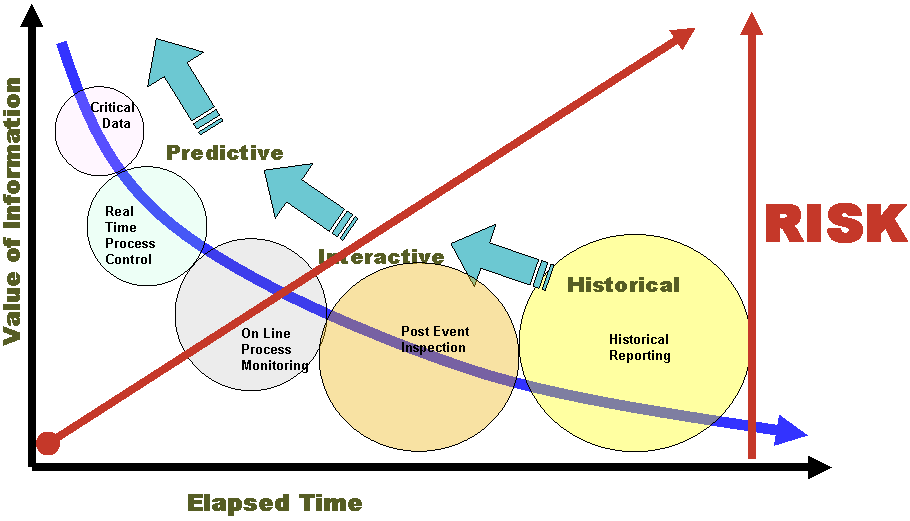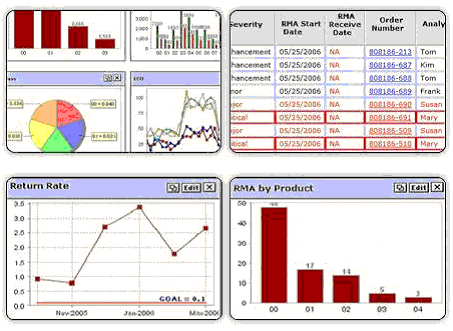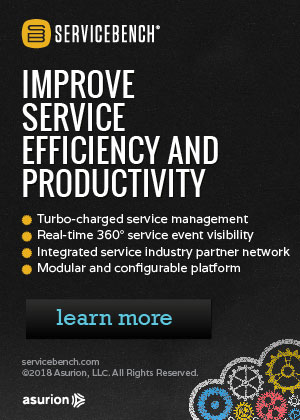Warranty Management: The Next Frontier in Cost Reduction and Product Quality Improvement? A new approach for exploiting warranty data offers manufacturing organizations a means of quickly finding and fixing product failures.
By Al Alaverdi and Nader Fathi, SigmaQuest
Detecting and correcting field product failures and operational problems has not traditionally been a primary area of focus for manufacturing organizations. In fact, in many instances problems are not identified until a product is in the hands of a customer. And even then corrective action may lag six to 12 months behind the initial occurrence of product failure (see Figure 1).
The effect of such sluggish attention is dramatic, resulting in massive losses in unnecessary warranty claims, bad production and customer dissatisfaction. By one estimate alone, American manufacturers reserve and will spend $30 billion in 2006 on warranty reserves. This cost, coupled with today's increasingly elaborate supply chain, outsourcing of manufacturing and support operations, and fragmented end-user manufacturer data processes, further complicates an already complex and costly problem.
Manufacturing organizations are now being forced to find a way to enhance product quality while at the same time reducing warranty costs. Accomplishing the latter goal requires a reduction in the rate of returns or Returned Material Authorization (RMA). But with little access to, or comprehensive knowledge of, products returned by end users, accomplishing this is difficult at best.
The answer to this dilemma lies in the adoption of a new approach to warranty management. As opposed to a supply chain accounting function, warranty data must now become a critical component of product quality lifecycle management. It must work hand in hand with a company's manufacturing and supply chain strategy to promote product improvement opportunities that yield the highest return. By exploiting warranty data in this manner, manufacturers not only improve their ability to detect and respond to problems, but also ensure that these problems are not passed from one product design to another.
Figure 1
Value of Information Decreases with Time
And Risk Increases
Figure 1. This graphic, courtesy of AMR Research Inc.,
illustrates that the value of information decays with
time, while the risk increases.
A Closer Look
Warranty data is one of a very few sources that provides manufacturers access to information regarding product operation and failures. It can also serve as an indicator into the customers' level of satisfaction, or dissatisfaction. When actively utilized throughout the product quality lifecycle, it becomes a powerful weapon for reducing RMA. But what is driving the intense focus on warranty management and the use of warranty data to reduce RMA and warranty cost? These factors include:
- The Disparate Views Across Multiple Organizations
Within most companies today there exists multiple organizations - such as engineering, quality assurance, manufacturing and field service - each typically operating independently of one another. The engineers don't talk to manufacturing who, in turn, doesn't talk to the field service who just talked to the end customer. This lack of communication means that when a product is returned, the company is generally at a loss as to the problem.
Consider the example of an Internet service provider (ISP) like Comcast which provides high-speed Internet access to end customers via set-top boxes obtained from third-party vendors. While it does not have direct access to the end customer, per se, it does reap the financial rewards when its customers are satisfied. When customers are unhappy, it reflects poorly on the company and its profit margin.
Unfortunately for Comcast, when the customer is dissatisfied and a set-top box is returned it often doesn't know why. Did the customer know how to use the set-top box properly? Did the set-top box experience a problem or have a design flaw? Without being able to answer these questions, Comcast or any other ISP for that matter, has little hope of reducing the rate of returns and therefore costs, or ensuring customer satisfaction.
These days it is increasingly common for a company to outsource manufacturing and support operations. While in many cases, this approach offers a number of significant benefits it can also create some challenges - one of which is the ability for a company to identify the root cause of a problem.
The automotive industry offers a prime example of this challenge. Today roughly 50% of a car's value resides in its electronics. Because the car's environment is so harsh, in terms of temperature and vibrations, the electronics is perhaps the single hardest thing for the automotive industry to deal with; especially considering that cars are mission critical and the cost of an automobile recall is extremely expensive. As a result, many have simply opted to outsource the car's electronics. But what happens when a car has a problem. Is the problem the result of a specific piece of electronics and if so, which one? If quality information and warranty data are not somehow tied together from all of the organizations involved in manufacturing the car's electronics, then how can the root cause of the problem ever be quickly and easily identified?
- Inability To Locate A Problem's Source
Dealing with product returns is an extremely costly proposition - made even more so when the source of a problem can't be properly identified. Consider, for example, a technician sent on a product service call that is unable to find the source of a product's problem. In this case, the technician must ship the product back to the factory at a cost of $500. For one typical hi-tech company the cost of such "no trouble found" products equates to approximately two million dollars per quarter.
In situations where even the factory is unable to find the problem, the product may be put back into inventory and eventually shipped to a new customer; only to be shipped back to the factory at a later date when the original problem resurfaces. Occurrences like this can have a significant impact on customer satisfaction as well as on a company's brand image.
Over the last few years, compliance initiatives have begun to play a critical role in the way large and mid-size manufactures manage warranty costs. The Sarbanes-Oxley Act of 2002, for example, established new and enhanced standards for all U.S. public company boards, management, and public accounting firms. As part of this legislation, public companies must now make their warranty reserves public. The problem, of course, is that matching warranty claims and accruals to reserves has always been a balancing act. Because it must now be done in public, it is harder for companies to conceal spikes in claims.
Another compliance example stems from the enactment of the Restriction of Hazardous Substances (RoHS) directive which went into effect in July of 2006. RoHS is part of a growing wave of environmental regulations, or green initiatives, and requires that six hazardous substances, including lead, be removed from all electrical and electronic equipment. Unfortunately, as companies transition their products from leaded to unleaded, they really have no way of knowing what, if any, impact there will be on the end product.
Companies like Comcast and others are now more desperate than ever before to gain access to end product warranty data. In all instances cited above, its effective use can play a crucial role in solving the challenges manufacturing organizations now face. In situations where a company is dealing with multiple organizations or has a high rate of returns, many of which are "no trouble found," access to the data provides them with the ability to quickly dig down to the source of a problem. Warranty data also can be instrumental in a company's quality improvements and claims reductions, which ultimately translate to bottom-line gains by reducing the need for warranty reserves.
A Better Way
Key to enhancing product quality, while reducing returns and warranty costs, is adoption of a software solution that utilizes warranty data as a central component in driving the product quality lifecycle of current and future products (see Figure 2). Utilizing this approach, manufacturing organizations can quickly and more efficiently detect and respond to product problems. They can even gain better insight into predicting and avoiding future problems. In addition to achieving higher quality products and minimizing service and warranty costs, proper use of warranty data ensures organizations maintain an excellent reputation with their customer base.
Figure 2
SigmaSure RMA Insight
Figure 2. SigmaSure RMA Insight, from SigmaQuest, is a
web-based software solution which enables OEMs to gain
comprehensive knowledge of products returned by end users.
Its web-based dashboard allows for management by exception.
While there are a number of companies purporting to offer solutions which make effective use of warranty data, it's important to select one that offers the functionality required to address all of the challenges facing today's manufacturing organizations. Rather then being based on the use of spreadsheets and manual analysis, for example, the web-based software solution should be available off-the-shelf and be capable of pulling together and analyzing data from disparate RMA databases in real-time. It should allow multiple organizations, including suppliers and subcontract manufacturers, to quickly drill down to a range of information regarding what failed in a product, when it failed and how the failure occurred.
In particular, the functionality that an effective warranty management solution should have includes the following:
- Must be able to find & fix problems.
The software must aggregate parts or product data from various RMA databases so that users can quickly learn the root causes of product defects - whether it's a problem with the design, process or supplier - and gain other statistical knowledge about product performance trends. With this type of information, OEMs can more quickly make product upgrades and notify their supplier and customers faster when recalls are required. Also, they can ensure that the right amount of spare parts or replacement inventory is available.
- Must be able to predict/avoid problems.
The software solution should incorporate appropriate corrective actions into the supply chain and manufacturing processes, so that the user can gain even better insight into predicting and avoiding future problems. It should correlate RMA data with supplier quality, design, manufacturing test data and genealogy to provide insight into the product lifecycle and create proactive, rather than reactive, service organizations.
- Must be able to feed data into the design and manufacturing to improve and innovate.
The solution should allow all information regarding tracking and reporting RMA, failure, and corrective action to be fed back into the design and manufacturing. Doing so, allows the user to perform real-time analysis to identify potential trends and innovative ways in which the design can be improved.
A prime example of a solution that meets the criteria outline above is SigmaSure RMA Insight. Designed for use as a stand-alone product offering, or available as part of SigmaQuest's SigmaSure Enterprise Suite, it allows users to correlate warranty data with supplier, design, and manufacturing test and repair data. Architected for the Web, it can be accessed via any Web browser and can also be easily deployed across multiple sites with differing computing infrastructures as an on-demand solution.
The Bottom Line
Warranty data is one of the few links manufacturing organizations have to vital information regarding a product's operation and failures. Solutions like SigmaSure RMA Insight now provide users with an effective way to interrogate this data to quickly detect and respond to product problems. These solutions are now on the frontline, helping manufacturing organizations to enhance product quality, reduce warranty costs, satisfy customers and, in general, to maintain a competitive advantage in the dynamically changing landscape of today's high-tech industry.
Nader Fathi is the chief executive officer of SigmaQuest, the leading provider of Product Performance Intelligence software solutions. Prior to co-founding SigmaQuest, Nader was vice president of worldwide sales operations and emerging markets at IKOS Systems (now part of Mentor Graphics Corporation). He also spent seven years at Cadence Design Systems and held various management positions with Dazix (an Intergraph company) and Xerox Microelectronics. Nader has a BSEE and an MSEE from University of Southern California and a business management certificate from UCLA Anderson Graduate School of Management.
Al Alaverdi is the vice president of technology of SigmaQuest. Prior to co-founding SigmaQuest, Al was the President of CodeServ, a software consulting company helping companies like Anritsu, Sun and Solectron obtain real-time visibility into their Product Performance to expedite failure analysis and corrective action. Prior to that he held various engineering roles within Amdahl Manufacturing, helping the company achieve world class quality. Al has a BSCE from University of Illinois at Champagne-Urbana and MSCE from Santa Clara University.
| 









